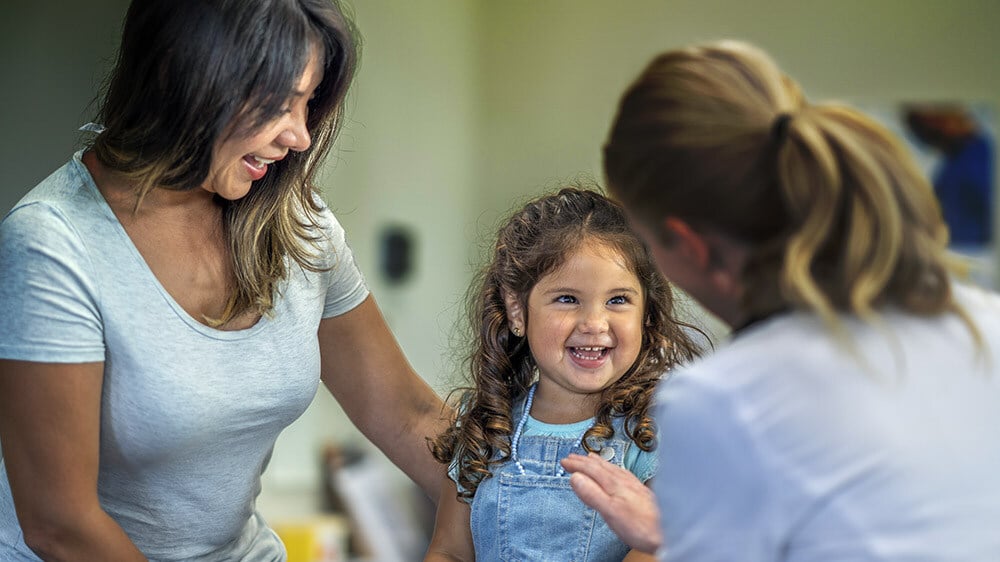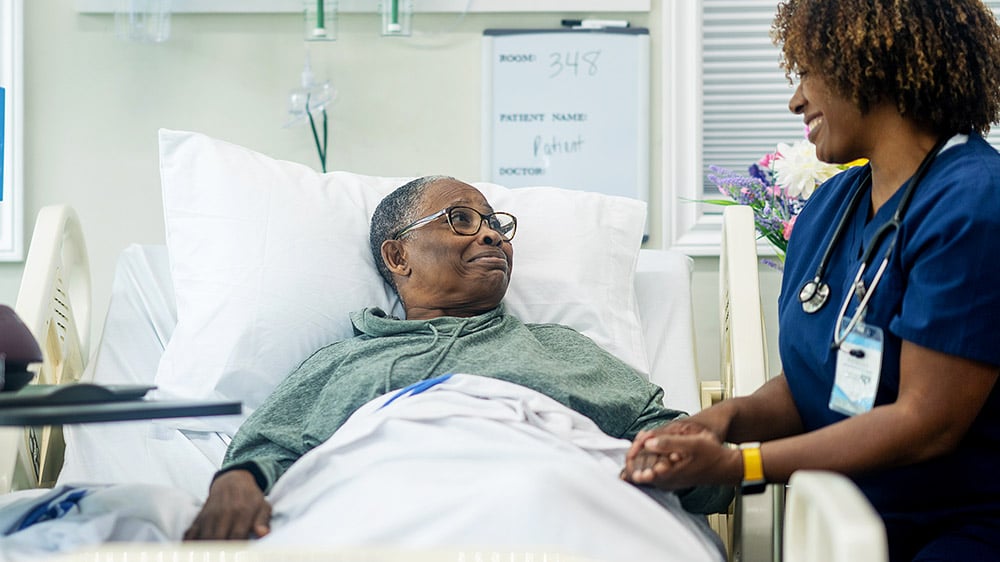
Population health is a very broad topic; it’s not just about collecting and analyzing data.
For us at Frisbie Memorial Hospital, it’s been about finding creative ways to address the health concerns that we identify in our patients, understanding that we need to keep them healthy outside the hospital walls.
Not too long ago, we’d have 10 or 15 people who would come in to the ED routinely, every Saturday night between 5 and 7, presenting with belly pain. Our providers would do the work-up, putting them through a full exam. While they’re there, they’d be given a sandwich. Once they ate, the belly pain would go away, and out the door they’d go.
While it wasn’t a large number of people, we were seeing an impact on our ED — not only in the time our providers spent with them, but in financial cost: We estimated that we were spending $15,000 a month on the Saturday night ED visits by people who we were then sending right back out.
Eventually, we realized that they just needed a meal to tide them over to Sunday, when they could find other food programs in town.
We also realized that we weren’t truly addressing the underlying issue of hunger in our town — until an overheard conversation put us on a course to make a huge difference for our hospital, and the community.
Finding new ways to help
It started at a Rotary club meeting.
Two members were talking about a high school drop-in center; I was expecting to hear about things like flat-screen TVs and video games, and instead I was hearing about showers and washing machines.
So I approached one of the people I’d overheard, our community police officer Sgt. Mike Neely, and I said, “I’m confused.”
Sgt. Neely explained that our town, Rochester, N.H., has a significant population of “families in transition.” They’re living out of cars or couch-hopping because they don’t have any permanent residence.
And so a group of school and town leaders created a community space for the kids to do their homework and do their laundry and take a shower. This allows them to take care of their basic needs for hygiene and clean clothes; it also means they’re not subject to bullying by other kids.
Sgt. Neely also mentioned that many of these students get a meal on Friday afternoon at school, but they go from Friday noontime to potentially Sunday night without food.
And that really bothered me.
I thought, “Here we are at Frisbie, a $350-million corporation in this community that supports us in so many different ways — we’re going to do something about this.”
Teaming up to deliver proper nutrition
So I went in search of a location that would be central in the town and could host a Saturday afternoon meal program. Grace Community Church, located right in the heart of Rochester, offered its kitchen and dining room — but there was a catch: Their kitchen has no stove and no sink, meaning we’d have to make the meals at Frisbie and transport them to the church every week.
There was another challenge we faced, though — Grace Church doesn’t have an elevator, so everything we brought there had to be carried downstairs by hand.
Fortunately, our food provider, Unidine, stepped up and said they’d be able to meet these challenges. Just as they do at the hospital, Unidine makes all of the community meals from scratch, with fresh ingredients.
We’ve set that standard for our hospital because we believe that fresh food is a key part to health and wellness, and ultimately part of healing our patients.
The Unidine staff identified a time when their stoves are available, and offered to cook the meals at Frisbie and prepare them for delivery. Then, Frisbie employees organized volunteer teams of eight people that would rotate Saturdays to bring the food and serve the people who showed up.
I was overwhelmed with the volunteers’ enthusiasm and willingness to help, and it’s a tribute to the dedication and compassion of Frisbie and Unidine employees that getting them on board for this effort was actually the least difficult part of the process.
Serving up dignity
Beyond providing healthy food to the 100 people or so who visit the community meal, I’ve made it a goal to support their dignity, as well.
For example, as our guests sit down to be served by our teams of volunteers. This gives people a chance to be seated at a table and served — instead of having to stand in line for a hand-out.
We also set clear nutritional goals for our visitors; they have to have salad with their meal, and dessert is always fresh fruit. This further improves their health, both physical and emotional, since they have access to food that they may otherwise not get.
And our support doesn’t end at 5 p.m. when the program closes; every person receives a take-out meal in a container that’s small enough to use in a convenience store microwave, so that they can easily heat up another meal when they need it.
Lowering barriers to health for patients
The community meal — along with the many other resources that we offer at Frisbie, like our Frisbie Smiles school-based dental health program, and chronic health and substance abuse recovery interventions — has not only met an immediate need for people in Rochester, but it has also reduced ED visits by people who simply needed something to eat.
Remember those 10 to 15 folks I mentioned who’d show up every week in the ED?
After starting the community meal, their ED visits stopped. They were getting food when they needed it, and didn’t have to come to the emergency room for it any more.
In addition, we also saw a financial benefit for the hospital: It costs us approximately $350 each to treat these patients before starting the community meal. That’s $15,000 in a year.
What we found was, the cost of treating all these patients in a month’s time more than pays for all the food over the course of a year. And, of course, we’re providing this food free of charge, so the patients can use their limited resources for other things they need.
Far beyond the financial savings, though, was the verifiable benefit to the overall health of our patients — not just physical, but mental, spiritual, and emotional.
As we work in our community, that’s why we’re here. We are very patient-centered and we really take to heart that we’re a true community hospital.
That’s our mission; that’s what population health means to us.
Finding opportunities for your hospital
As you consider your patient population and what it means to truly serve the needs of your community, my advice is to keep an open mind, open ears, and open eyes.
- Start with the patients who are already coming to your hospital: Is there a high frequency of one or another condition? Are you seeing the same people every week for the same thing, as Frisbie was on those Saturday nights before the community meal program? Is there another way to respond to their needs outside of ED admissions?
- Look into resources that already exist in your community. Every city and town has some version of a community action program, a nonprofit organization funded by federal and state grants that is always looking for new clients to serve and support. Your town may also have church-based agencies that support the homeless or other at-risk populations. These groups often don’t know about people in need unless someone tells them.
- If there’s no existing program to address the need you’ve identified, create one. Hospitals are highly visible community organizations, often employing hundreds of local residents and benefitting from a positive image and reputation among community leaders. Communicate with those leaders — elected officials, businesspeople, public safety officers, nonprofit executives — and show that you’re willing to head up a new initiative. Energize and inspire your staff to get involved, to see the community beyond the hospital’s walls and reconnect with the people who they may see as “just patients.”
- Remain open to new ideas, and allow yourself to be surprised. You may go into a new community program thinking you know what will happen; with a food program, you might think people getting food is the goal. And like we saw at Frisbie, you may be surprised at what else you can provide: Better dental health and a higher sense of dignity.
- Finally, remember that any community program should primarily be about the community. Your hospital will get recognition [and potentially additional patients] as a natural result of providing these resources; you won’t have to spend a lot of time “branding” the outreach effort. Show that you’re invested in the community, listening, learning, and responding. The results of your efforts will speak for themselves.
Subscribe to MEDITECH's blog to get more great insights from industry leaders:




